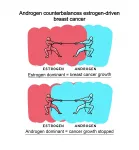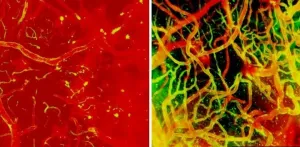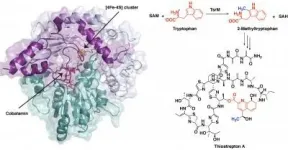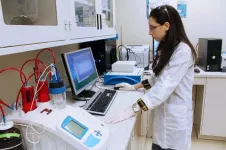The approach is being developed specifically as a potential treatment for the significant fraction of people with debilitating depression who do not respond to existing therapies and are at high risk of suicide.
"The brain, like the heart, is an electrical organ, and there is a growing acceptance in the field that the faulty brain networks that cause depression -- just like epilepsy or Parkinson's disease -- could be shifted into a healthier state by targeted stimulation," said Katherine Scangos, MD, PhD, an assistant professor in the Department of Psychiatry and Behavioral Sciences and corresponding author of the new study. "Prior attempts to develop neuromodulation for depression have always applied stimulation in the same site in all patients, and on a regular schedule that fails to specifically target the pathological brain state. We know depression affects different people in very different ways, but the idea of mapping out individualized sites for neuromodulation that match a patient's particular symptoms had not been well explored."
In a case study published January 18, 2021 in Nature Medicine, Scangos and colleagues mapped the effects of mild stimulation of several mood-related brain sites in a patient with severe treatment-resistant depression. They found that stimulation at different sites could alleviate distinct symptoms of the brain disease -- reducing anxiety, boosting energy levels, or restoring pleasure in everyday activities -- and, notably, that the benefits of different stimulation sites depended on the patient's mental state at the time.
The proof-of-concept study lays the groundwork for a major five-year clinical trial Scangos is leading, called the PRESIDIO trial, that will evaluate the effectiveness of personalized neuromodulation in 12 patients with severe treatment-resistant depression. The trial will build on the current study by identifying brain signatures that reflect individual participants' symptoms. With this information, neuromodulation devices can be programmed to respond in real time to these faulty network states with targeted stimulation that brings patients' brain circuits back into balance.
"We've developed a framework for how to go about personalizing treatment in a single individual, showing that the distinctive effects of stimulating different brain areas are reproducible, long-lasting and state-dependent," said Andrew Krystal, MD, director of UCSF's Dolby Center and co-senior author on the new study. "Our trial is going to be groundbreaking in that every person in the study is potentially going to get a different, personalized treatment, and we will be delivering treatment only when personalized brain signatures of a depressed brain state indicate treatment is needed."
Epilepsy Studies Laid Groundwork for Depression Neuromodulation Trial
Depression is among the most common psychiatric disorders, affecting as many as 264 million people worldwide and leading to hundreds of thousands of deaths per year. But as many as 30 percent of patients do not respond to standard treatments such as medication or psychotherapy. Some of these individuals respond positively to electroconvulsive therapy (ECT), but stigma and side effects make ECT undesirable for many, and one in ten patients experience little benefit even from ECT.
Previous research by Edward Chang, MD, co-senior author of the new study, has demonstrated the potential of brain mapping to identify promising sites for mood-boosting brain stimulation. These studies were conducted at UCSF Epilepsy Center in patients with and without clinical depression who already had electrode arrays implanted in their brains to map seizures ahead of epilepsy surgery.
"Our prior work showed a proof of principle for targeted stimulation across brain areas to treat mood symptoms, but an outstanding question has been whether the same approach would hold true for patients with depression alone," said Chang, who is the Joan and Sanford I. Weill Chair of the UCSF Department of Neurological Surgery and Jeanne Robertson Distinguished Professor.
Brain Mapping Case Study Illustrates Personalized Neuromodulation and Symptom Relief
In the new study, the UCSF team demonstrated the use of a similar brain-mapping approach to identify patient-specific therapeutic stimulation sites as the first phase of the PRESIDIO trial.
The team used a minimally invasive approach called stereo-EEG to place 10 intracranial electrode leads into the brain of the first patient enrolled in the trial -- a 36-year-old woman who has experienced multiple episodes of severe treatment-resistant depression since childhood. The patient then spent 10 days at the UCSF Helen Diller Medical Center at Parnassus Heights while researchers systematically mapped effects of mild stimulation across a number of brain regions that prior research had shown were likely to have an effect on mood.
The researchers found that 90-second stimulation of a several different brain sites could reliably produce an array of distinctive positive emotional states, as measured by a set of clinical scales that were used to assess the patient's mood and depression severity throughout the study. For example, after stimulation of one region, the patient reported "tingles of pleasure," while stimulation of a second area resulted in a feeling of "neutral alertness ... less cotton and cobwebs." Stimulation of a third area -- a region called orbitofrontal cortex (OFC) that had been identified in Chang's earlier studies -- produced a sensation of calm pleasure "like ... reading a good book."
The team then tested more prolonged (three- to 10-minute) stimulation of these three areas to attempt longer-lasting relief of the patient's depression symptoms. To their surprise, they found that stimulation of each of the three sites improved her symptoms in different ways, depending on the patient's mental state at the time of stimulation. For example, when she was experiencing anxiety, the patient reported stimulation of the OFC as positive and calming, but if the same stimulation was delivered when she was experiencing decreased energy, it worsened her mood and made her feel excessively drowsy. The opposite pattern was observed in the other two regions, where stimulation increased the patient's arousal and energy level.
"I've tried literally everything, and for the first few days I was a little worried that this wasn't going to work," the patient recalled. "But then when they found the right spot, it was like the Pillsbury Doughboy when he gets poked in the tummy and has that involuntary giggle. I hadn't really laughed at anything for maybe five years, but I suddenly felt a genuine sense of glee and happiness, and the world went from shades of dark gray to just--grinning."
The researchers focused in on an area known as the ventral capsule/ventral striatum, which seemed to best address this particular patient's primary symptoms of low energy and loss of pleasure in everyday activities.
"As they kept playing with that area, I gradually looked down at the needlework I had been doing as a way to keep my mind off negative thoughts and realized I enjoyed doing it, which was a feeling I haven't felt for years," she said. "It struck me so clearly in that moment that my depression wasn't something I was doing wrong or just needed to try harder to snap out of -- it really was a problem in my brain that this stimulation was able to fix. Every time they'd stimulate, I felt like, 'I'm my old self, I could go back to work, I could do the things I want to do with my life.'"
The researchers found that the effects of stimulation could be tailored to the patient's mood, and that positive effects lasted for hours, well beyond the 40-minute window designed into the study protocol. The patient's symptoms also got significantly better over the course of the 10-day study, leading to a temporary remission lasting 6 weeks.
"The fact that we could eliminate this patient's symptoms for hours with just a few minutes of targeted stimulation was remarkable to see," Krystal said. "It emphasizes that even the most severe depression is a brain circuit disease that may just need a targeted nudge back into a healthy state. Unlike antidepressant drugs, which might not have an effect for one to three months, probably by altering brain circuits in ways we don't understand, our hope is that this approach will be effective precisely because it only requires brief, mild stimulation when the undesired brain state we want to change is present."
Promising Initial Results of Real-Time, Targeted Neuromodulation Seen in Ongoing Trial
When the patient's symptoms returned after her initial remission, the researchers proceeded to the next phase of the PRESIDIO trial -- implanting a responsive neuromodulatory device called the NeuroPace RNS System. This device is widely used for seizure control in epilepsy patients, in whom it can detect signs of oncoming seizures in real time and initiate brief, targeted stimulation that cancels them out. In the PRESIDIO trial, the device instead detects signature patterns of brain activity that indicate that a participant is moving towards a highly depressed state, and then provides mild, undetectable levels of stimulation to a targeted brain region to counteract this downswing.
"We hope that providing gentle neuromodulation throughout each day will be able to prevent patients from falling into long-lasting depressive episodes," said Scangos, who was recently awarded a 1907 Research Trailblazer Award for her work to understand depression's neural circuitry. "The idea is that keeping neural circuit activity functioning along the correct track, the pathways that support pathological negative thought processes in depression can be unlearned."
The NeuroPace device was implanted in June of 2020 and activated in August, and so far, the study participant has reported that her symptoms -- which in the past seven years had made it impossible for her to hold a job or even drive -- have almost completely vanished, despite significant life stressors like a COVID exposure, helping her parents move out of state, and caring for her mother after a fall.
"2020 was terrible for everyone, and I've had some particularly stressful life events, but for the first time in a long time, I feel like I can bob back up again," she said. "I can't tell exactly when the device turns on, but I generally feel more of a sense of clarity, an ability to look at my emotions rationally and apply the tools that I've worked on through psychotherapy, and that is so far from where I was before."
In the trial's next phase, the patient will switch between six weeks with the device turned on and six weeks with it off, without being aware of which is which, in order to assess possible placebo effects.
INFORMATION:
Authors: The study's authors were Katherine Scangos, Ghassan Makhoul, Leo Sugrue, Edward Chang, and Andrew Krystal, all of UCSF.
Funding: This research was supported by the U.S. National Institutes of Health (NIH K23NS110962), a NARSAD Young Investigator grant from the Brain and Behavioral Research Foundation, and by the Ray and Dagmar Dolby Family Fund through the UCSF Department of Psychiatry and Behavioral Sciences.
Disclosures: Krystal consults for Eisai, Evecxia, Ferring, Galderma, Harmony Biosciences, Idorsia, Jazz, Janssen, Merck, Neurocrine, Pernix, Sage, and Takeda. UCSF and Chang have intellectual property related to brain decoding and stimulation therapies. All other authors declare no competing interests.
About UCSF: The University of California, San Francisco (UCSF) is exclusively focused on the health sciences and is dedicated to promoting health worldwide through advanced biomedical research, graduate-level education in the life sciences and health professions, and excellence in patient care. UCSF Health, which serves as UCSF's primary academic medical center, includes top-ranked specialty hospitals and other clinical programs, and has affiliations throughout the Bay Area. Learn more at ucsf.edu, or see our Fact Sheet.
Follow UCSF
ucsf.edu | Facebook.com/ucsf | YouTube.com/ucsf






